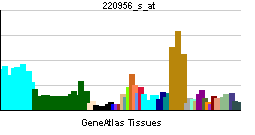EGLN2
| Egl nine homolog 2 (C. elegans) | |||||||||||
|---|---|---|---|---|---|---|---|---|---|---|---|
| Identifiers | |||||||||||
| Symbols | EGLN2 ; DKFZp434E026; EIT6; HIFPH1; PHD1 | ||||||||||
| External IDs | Template:OMIM5 Template:MGI HomoloGene: 14204 | ||||||||||
| |||||||||||
| RNA expression pattern | |||||||||||
 | |||||||||||
| More reference expression data | |||||||||||
| Orthologs | |||||||||||
| Template:GNF Ortholog box | |||||||||||
| Species | Human | Mouse | |||||||||
| Entrez | n/a | n/a | |||||||||
| Ensembl | n/a | n/a | |||||||||
| UniProt | n/a | n/a | |||||||||
| RefSeq (mRNA) | n/a | n/a | |||||||||
| RefSeq (protein) | n/a | n/a | |||||||||
| Location (UCSC) | n/a | n/a | |||||||||
| PubMed search | n/a | n/a | |||||||||
Egl nine homolog 2 (C. elegans), also known as EGLN2, is a human gene.[1]
The hypoxia inducible factor (HIF) is a transcriptional complex which is involved in oxygen homeostasis. At normal oxygen levels, the alpha subunit of HIF is targeted for degration by prolyl hydroxylation. This gene encodes an enzyme responsible for this posttranslational modification. Multiple alternatively spliced variants, encoding the same protein, have been identified.[1]
References
Further reading
- Semenza GL (2001). "HIF-1, O(2), and the 3 PHDs: how animal cells signal hypoxia to the nucleus". Cell. 107 (1): 1–3. PMID 11595178.
- Hartley JL, Temple GF, Brasch MA (2001). "DNA cloning using in vitro site-specific recombination". Genome Res. 10 (11): 1788–95. PMID 11076863.
- Wiemann S, Weil B, Wellenreuther R; et al. (2001). "Toward a catalog of human genes and proteins: sequencing and analysis of 500 novel complete protein coding human cDNAs". Genome Res. 11 (3): 422–35. doi:10.1101/gr.154701. PMID 11230166.
- Jaakkola P, Mole DR, Tian YM; et al. (2001). "Targeting of HIF-alpha to the von Hippel-Lindau ubiquitylation complex by O2-regulated prolyl hydroxylation". Science. 292 (5516): 468–72. doi:10.1126/science.1059796. PMID 11292861.
- Ivan M, Kondo K, Yang H; et al. (2001). "HIFalpha targeted for VHL-mediated destruction by proline hydroxylation: implications for O2 sensing". Science. 292 (5516): 464–8. doi:10.1126/science.1059817. PMID 11292862.
- Taylor MS (2001). "Characterization and comparative analysis of the EGLN gene family". Gene. 275 (1): 125–32. PMID 11574160.
- Epstein AC, Gleadle JM, McNeill LA; et al. (2001). "C. elegans EGL-9 and mammalian homologs define a family of dioxygenases that regulate HIF by prolyl hydroxylation". Cell. 107 (1): 43–54. PMID 11595184.
- Bruick RK, McKnight SL (2001). "A conserved family of prolyl-4-hydroxylases that modify HIF". Science. 294 (5545): 1337–40. doi:10.1126/science.1066373. PMID 11598268.
- Seth P, Krop I, Porter D, Polyak K (2002). "Novel estrogen and tamoxifen induced genes identified by SAGE (Serial Analysis of Gene Expression)". Oncogene. 21 (5): 836–43. doi:10.1038/sj.onc.1205113. PMID 11850811.
- Min JH, Yang H, Ivan M; et al. (2002). "Structure of an HIF-1alpha -pVHL complex: hydroxyproline recognition in signaling". Science. 296 (5574): 1886–9. doi:10.1126/science.1073440. PMID 12004076.
- McNeill LA, Hewitson KS, Gleadle JM; et al. (2002). "The use of dioxygen by HIF prolyl hydroxylase (PHD1)". Bioorg. Med. Chem. Lett. 12 (12): 1547–50. PMID 12039559.
- Oehme F, Ellinghaus P, Kolkhof P; et al. (2002). "Overexpression of PH-4, a novel putative proline 4-hydroxylase, modulates activity of hypoxia-inducible transcription factors". Biochem. Biophys. Res. Commun. 296 (2): 343–9. PMID 12163023.
- Ivan M, Haberberger T, Gervasi DC; et al. (2002). "Biochemical purification and pharmacological inhibition of a mammalian prolyl hydroxylase acting on hypoxia-inducible factor". Proc. Natl. Acad. Sci. U.S.A. 99 (21): 13459–64. doi:10.1073/pnas.192342099. PMID 12351678.
- Strausberg RL, Feingold EA, Grouse LH; et al. (2003). "Generation and initial analysis of more than 15,000 full-length human and mouse cDNA sequences". Proc. Natl. Acad. Sci. U.S.A. 99 (26): 16899–903. doi:10.1073/pnas.242603899. PMID 12477932.
- Metzen E, Berchner-Pfannschmidt U, Stengel P; et al. (2003). "Intracellular localisation of human HIF-1 alpha hydroxylases: implications for oxygen sensing". J. Cell. Sci. 116 (Pt 7): 1319–26. PMID 12615973.
- Cioffi CL, Liu XQ, Kosinski PA; et al. (2003). "Differential regulation of HIF-1 alpha prolyl-4-hydroxylase genes by hypoxia in human cardiovascular cells". Biochem. Biophys. Res. Commun. 303 (3): 947–53. PMID 12670503.
- Ota T, Suzuki Y, Nishikawa T; et al. (2004). "Complete sequencing and characterization of 21,243 full-length human cDNAs". Nat. Genet. 36 (1): 40–5. doi:10.1038/ng1285. PMID 14702039.
- Aprelikova O, Chandramouli GV, Wood M; et al. (2004). "Regulation of HIF prolyl hydroxylases by hypoxia-inducible factors". J. Cell. Biochem. 92 (3): 491–501. doi:10.1002/jcb.20067. PMID 15156561.
- Colland F, Jacq X, Trouplin V; et al. (2004). "Functional proteomics mapping of a human signaling pathway". Genome Res. 14 (7): 1324–32. doi:10.1101/gr.2334104. PMID 15231748.
| This protein-related article is a stub. You can help Wikipedia by expanding it. |